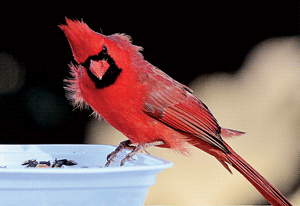IT’S SPRING
 Robins have returned after spending the winter farther south. I hear one or two singing from the trees in our yard when I step outside every morning, if it isn’t raining. I see one often on the lawn. Red-winged blackbirds are back and several call from the cattails of the marsh while others raid our bird feeders. Cardinals whistle from the trees and fly in and out of the feeders. Song sparrows sing.
Robins have returned after spending the winter farther south. I hear one or two singing from the trees in our yard when I step outside every morning, if it isn’t raining. I see one often on the lawn. Red-winged blackbirds are back and several call from the cattails of the marsh while others raid our bird feeders. Cardinals whistle from the trees and fly in and out of the feeders. Song sparrows sing.
Though the sky is often gray and the wind blows strong and cold, though there have been snow flurries recently and may be more, though the temperature drops to near freezing some nights, spring is here. Just look to the birds.
Those robins and redwings, cardinals and song sparrows that are singing are announcing that it’s spring. Not to us. The singers are male birds and with their singing they’re proclaiming territories, warning other males of their kind to keep out while inviting females to join them, to mate, to build nests and raise families. The pair of mute swans that claim our marsh as their home and have driven the Canada geese away have even started their families. They already have a nest and eggs and are incubating.
Those robins and redwings, cardinals and song sparrows, and particularly the swans are the early birds. Many birds are still moving north, still traveling to the places they will nest. I’m still seeing flocks of ducks, mallards and blue- and green-winged teal, scaup and ring-necked ducks, redheads and canvasbacks, pintails and wigeon, buffleheads and mergansers. Some of the mallards and perhaps a few blue-winged teal and hooded mergansers will stay and nest in Indiana but most of the ducks will soon be gone.
There are many more birds to come and many more that will nest in our area. Has anybody seen a Baltimore oriole yet this spring or a rose-breasted grosbeak or an indigo bunting? I’ve seen a chipping sparrow, which will nest in our area, and I have had someone send me a picture of a fox sparrow on the ground beneath his bird feeder, a bird that will nest farther north. But, I have not seen nor has anybody told me they’ve seen a white-crowned or a white-throated sparrow in our area this spring. I haven’t had anybody report seeing a house wren or a warbler, any warbler, in our area so far this spring.
Ahh, warblers. They, and many other little birds, migrate at night, feed during the day, especially morning and evening. They may rest during part of the day and move on the day after they arrive, those that nest farther north, or they may stay, feed and rest for a few days.
There is nothing more thrilling to me, except seeing a species of bird I have never seen before, than going to a woods where I have been recently, and seen few birds, and finding the trees and undergrowth, even the ground alive with warblers and other little birds. Twisting, turning, looking up, down, all around, aiming over and over to get a warbler in the view of my binoculars is one of the most enjoyable and exasperating activities.
Yellow-rumped warbler, redstart, Blackburnian warbler, Nashville, Tennessee, northern parula, chestnut-sided, bay-breasted, cerulean, black-and-white, black-throated blue, black-throated green, the list goes on and on. Spotting many in a day, having a warbler day in spring is enough to give a birder a sore neck, a warbler neck.
Sore neck or not, a warbler day is a special day and now is the time of year, toward the end of April and early in May. It’s also the time of year to see other migrants and buds on the trees opening and wildflowers blooming in the woods and along the roads. It’s the time of year for change. It’s spring.
- Birds As Weather Forecasters – Life In The Outdoors - December 17, 2021
- Rare Bird Spotted In Indiana – Life In The Outdoors - October 8, 2021
- MY EXPERIENCE WITH DEER – Life In The Outdoors - July 30, 2021


